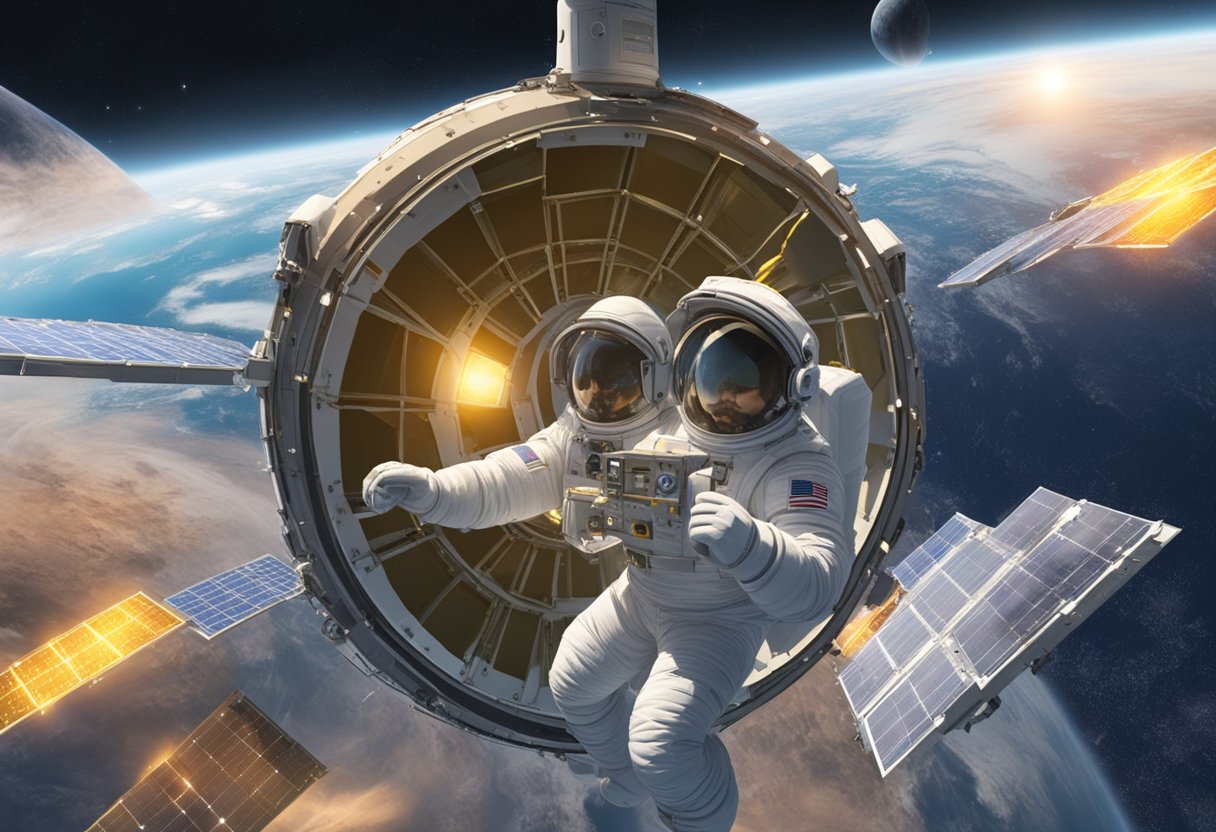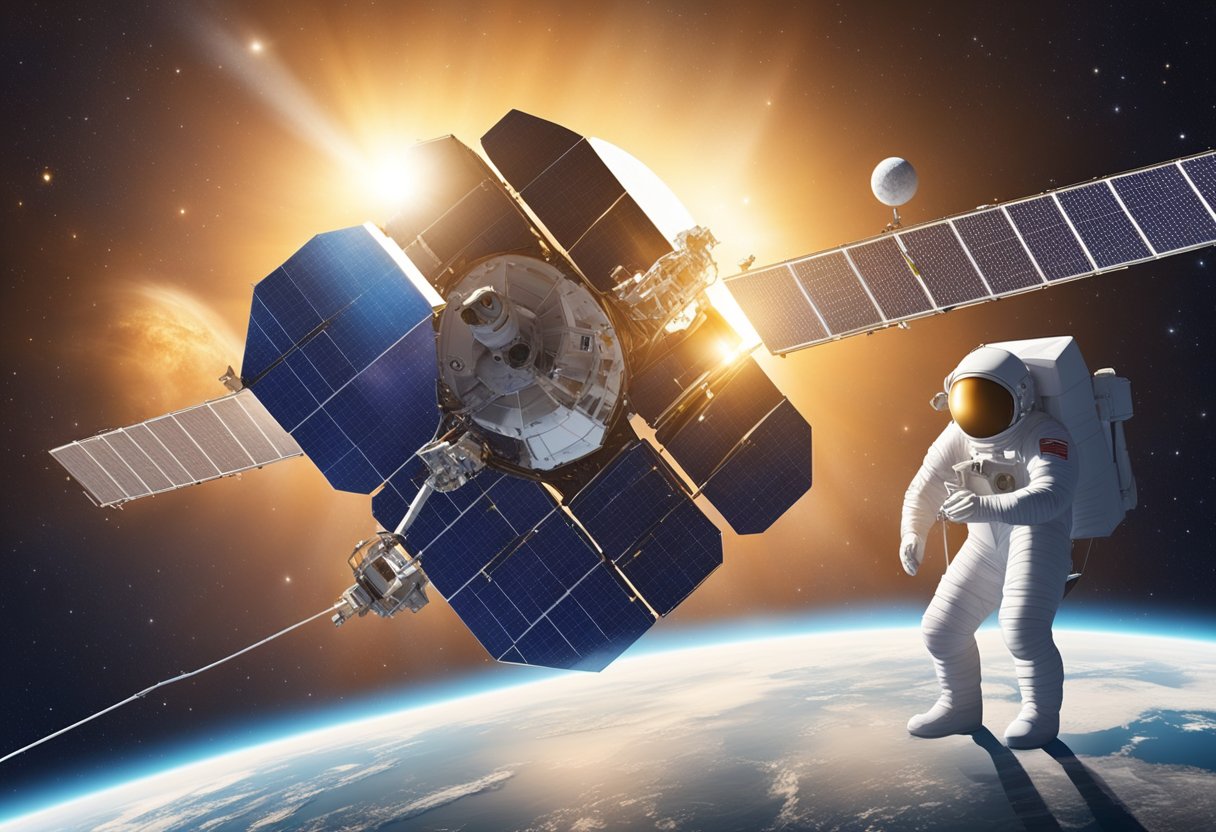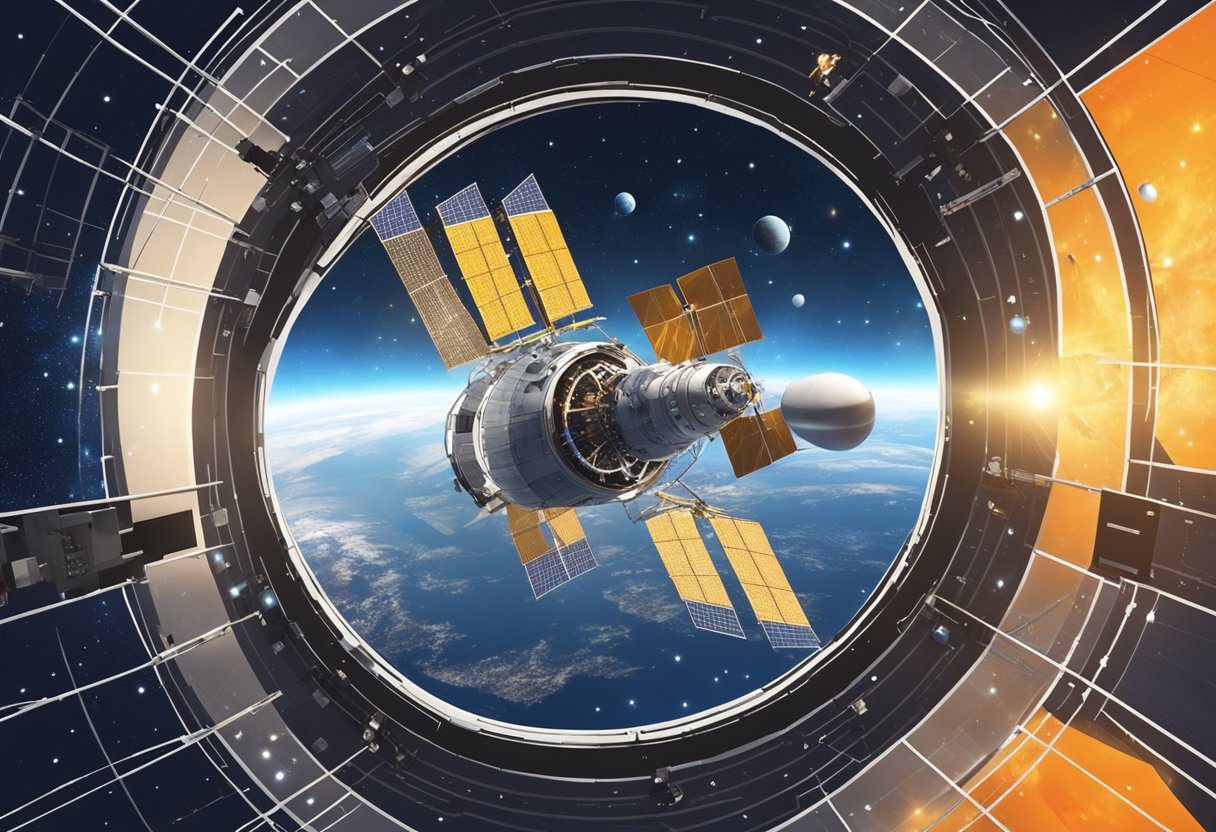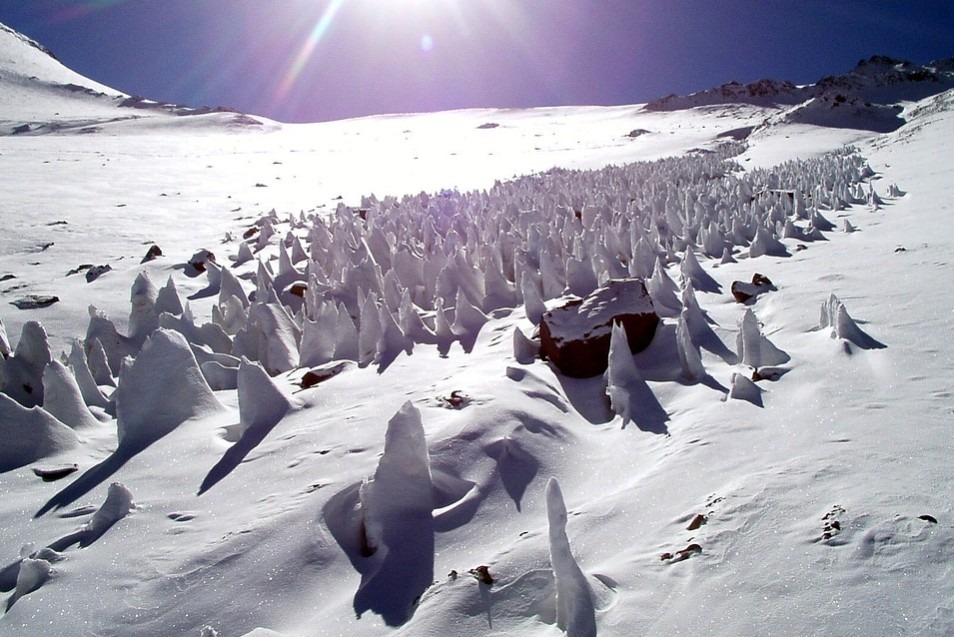How Space Weather Affects Astronauts and Satellites

Space weather, originating from the Sun’s activity, plays a crucial role in the safety and operation of astronauts and satellites. It generates solar flares and coronal mass ejections (CMEs) which release bursts of radiation and charged particles that can disrupt satellite electronics and pose serious health risks to astronauts. As they journey through space, astronauts must take preventive measures, such as finding shelter within their spacecraft during high radiation events.
Satellites face their own challenges. Space weather can interfere with crucial systems, degrading radio communications, GPS signals, and even affecting satellite orbits. Engineers often need to power down sensitive satellite systems to protect them from damage, ensuring these critical technologies continue to function properly for global communication and navigation.
Understanding space weather is vital for NASA and other space agencies to plan and execute missions safely. Historical events, like the drag experienced by NASA's Skylab in the 1970s due to increased solar activity, highlight the importance of monitoring and predicting space weather. These insights help safeguard both human and technological assets in space.
Understanding Space Weather
Space weather impacts astronauts and satellites significantly, influencing safety and functionality. This section dives into what space weather is and how it cycles through different phases.
Defining Space Weather
Space weather refers to changes in the space environment due to the Sun's activities. Mainly, it involves solar flares, coronal mass ejections (CMEs), and the solar wind. Each affects Earth's magnetosphere and can disrupt technology, including satellite communications and GPS signals.
Solar flares are bursts of radiation from the Sun's surface, sending charged particles and plasma into space. Coronal mass ejections are large expulsions of plasma and magnetic field from the Sun’s corona. These events cause geomagnetic storms that impact space-based technology and can pose risks to astronauts by exposing them to high radiation levels.
Heliophysics is the study of the Sun and its influence on the solar system, playing a crucial role in understanding space weather. By studying these phenomena, scientists can predict space weather events and mitigate their adverse effects.
The Solar Cycle
The solar cycle is an approximately 11-year cycle of solar activity, alternating between solar maximum and solar minimum. During a solar maximum, the Sun exhibits higher activity, with increased numbers of solar flares and CMEs. This period significantly impacts space weather, leading to more frequent geomagnetic storms.
In contrast, the solar minimum is marked by reduced solar activity. The frequency of flares and CMEs decreases, resulting in calmer space weather. Despite fewer events, communication and navigation systems in space can still be affected by slight variations in the solar wind and charged particles.
Understanding the solar cycle is key to predicting periods of intense space weather and planning accordingly. This includes scheduling space missions during solar minimum to reduce exposure to harmful radiation for astronauts. Scientists track the solar cycle through observations and models, helping to forecast space weather with greater accuracy.
Effects on the Earth's Environment
Space weather has significant impacts on the Earth's environment, specifically affecting the magnetic field and the atmosphere. These changes can influence communication systems, navigation, and even the climate.
Impact on Earth's Magnetic Field
The Earth's magnetic field acts as a shield against solar winds and cosmic radiation. When solar material ejected from the Sun hits this magnetic field, it can cause geomagnetic storms.
Geomagnetic storms can disrupt satellite operations and power grids on Earth. The interaction between solar wind and the magnetosphere can also produce stunning displays of aurora, such as the aurora borealis and aurora australis.
Solar radiation storms disturb the Van Allen radiation belts, which are zones of charged particles trapped by Earth's magnetic field. These disturbances increase radiation levels, posing risks to astronauts and satellites.
Atmospheric Responses
Space weather events also impact the Earth's atmosphere, particularly the ionosphere and thermosphere. Changes in these layers affect radio communication and GPS systems.
During a solar storm, increased solar radiation heats the thermosphere, causing it to expand. This expansion can increase drag on satellites, affecting their orbits.
The ionosphere plays a crucial role in transmitting radio waves. Variations in ionization levels can disrupt radio signals, causing communication blackouts. Geomagnetic storms can also induce currents in power lines, leading to electrical grid failures.
Increased solar activity can slightly alter the Earth's climate and temperature, although these effects are generally minor compared to natural climate variations.
Astronauts and Human Spaceflight

Astronauts face significant challenges due to the harsh conditions of space. Key issues include radiation exposure and daily life in a microgravity environment onboard the International Space Station (ISS).
Radiation Exposure in Space
Space is filled with harmful radiation from various sources. Solar radiation, which is comprised of charged particles like protons and electrons, constantly bombards the space environment. Coronal Mass Ejections (CMEs) and radiation storms can increase this exposure sharply. NASA tracks these events to predict and mitigate their effects.
Astronauts also face exposure to galactic cosmic rays (GCRs), which are high-energy particles from outside our solar system. The Earth’s magnetic fields and atmosphere usually protect against these particles, but in space, particularly at the polar regions, this protection is minimal. Spacecraft must have adequate shielding to protect astronauts from these threats.
Life Aboard the ISS
Life on the ISS revolves around research and maintenance tasks. With the station orbiting Earth every 90 minutes, astronauts experience multiple sunrises and sunsets each day. They need to adapt to microgravity, which affects muscle and bone density. Regular exercise is essential to counter these effects.
The ISS is a collaborative effort involving NASA and space agencies worldwide, creating a habitat that supports life and work in space. Daily routines include scientific experiments, health monitoring, and facility maintenance. The station has special areas for sleeping, eating, and working, ensuring astronauts can live somewhat comfortably during their missions.
Impact on Satellite Operations

Space weather has a significant impact on satellite operations, from communication and navigation to changes in orbital parameters due to varying atmospheric conditions.
Satellite Communication and Navigation
Solar flares and coronal mass ejections (CMEs) release large amounts of electromagnetic energy and charged particles. These events can lead to radio blackouts and disrupt HF radio communication essential for several satellite processes.
When Earth's magnetic field is disturbed, GPS signals used by navigation systems, like GPS systems and satellite-based navigation, can become inaccurate or even unavailable. For instance, during intense solar storms, solar radiation storms can degrade radio communications, causing considerable disruptions to Starlink and other communication satellites.
Solar radiation can also damage satellite components. The increased exposure to high-energy particles can affect the electronics and sensors of orbiting satellites. This can lead to temporary or permanent malfunctions, impacting both satellite communication and navigation capabilities.
Orbital Variable Changes
The space environment around Earth is influenced by space weather. One critical aspect is satellite drag, caused by increased atmospheric density during solar storms. Solar EUV (extreme ultraviolet) radiation heats the upper atmosphere, causing it to expand. This expansion increases the drag on satellites, affecting their orbital paths.
Another important factor is temperature fluctuations. Space weather can alter the thermal environment in space, which impacts satellite operations. For instance, satellites in low Earth orbit, including those conducting studies around the Moon, must account for these variable temperatures to maintain proper function.
Finally, charged particles from space weather events can build up static electricity on satellite surfaces, leading to electrical discharges. These discharges can damage sensitive instruments and modify satellite orbits. Operators must track such variations to ensure precise satellite positioning and to avoid potential collisions.
Technological and Infrastructural Effects
Space weather can significantly impact technology and infrastructure. Key areas affected include power systems and aviation, each facing unique challenges due to space weather phenomena such as geomagnetic storms and solar flares.
Power System Vulnerabilities
Geomagnetic storms can disrupt power grids. When a storm hits Earth, geomagnetically induced currents (GICs) can flow through power lines, transformers, and other infrastructure. This can cause overheating and potentially lead to blackouts. During intense storms, these currents can damage transformers, reducing their lifespan or causing them to fail entirely.
Power supplies can also be affected by electromagnetic radiation from solar flares. The radiation can interfere with the communication systems that power companies rely on to manage grids. Moreover, heat generated from these interactions can further strain electricity systems.
Space weather forecasting by agencies like NOAA is crucial. It helps power companies prepare for potential disruptions, mitigating the damage and maintaining stability. Early warnings allow for reducing load and protecting sensitive equipment, ensuring the reliability of the electrical power grid.
Risks to Aviation
Solar radiation storms pose risks to aviation. High-altitude flights, especially those crossing polar regions, are exposed to increased levels of radiation during these storms. This can pose health risks to crew and passengers and can also affect electronic systems on board.
Flares from solar activity release bursts of electromagnetic radiation that can disrupt GPS signals and high-frequency radio communications. These disruptions can impede navigation and communication for flights, leading to delays and potential safety concerns.
To mitigate these risks, continuous monitoring and space weather forecasting are essential. Airlines can adjust flight paths and altitudes to avoid highly affected areas. Accurate forecasts help minimize exposure to harmful radiation, ensuring safe and efficient operations.
Monitoring and Forecasting Space Weather
Accurate monitoring and forecasting of space weather are crucial for protecting astronauts and satellites. These processes rely on several key organizations and advanced tools to gather and interpret data.
Observation and Forecasting Organizations
Multiple organizations monitor and forecast space weather. NOAA and NASA are significant players. NOAA's Space Weather Prediction Center (SWPC) uses a network of solar observatories and satellites. NASA collaborates with other space agencies to study solar activity and its impacts.
European Space Agency’s Solar Orbiter and NASA’s Parker Solar Probe help collect detailed information about the Sun. The Solar and Heliospheric Observatory (SOHO) provides data on sunspots and solar flares. This collaborative international effort aims to predict solar storms and their effects on Earth and interplanetary space.
Tools for Monitoring Space Weather
Several tools are used for monitoring space weather. Satellites like GOES provide real-time data on solar and space weather events. NOAA Space Weather Scales, such as R1-R2 and S1 or greater, help measure and communicate the severity of solar activities.
Ground-based observatories track sunspots, an indicator of the Sun's 11-year solar cycle. NASA's STEREO spacecraft give a 3D view of solar events. These tools gather critical data to inform forecasts and mitigate risks to space missions and technology on Earth. Data from these tools help organizations like the SWPC to issue timely forecasts.
Preparing for Space Weather Events
Effective preparation for space weather events involves coordinated efforts by government agencies and adherence to specific guidelines by the community and industries. These efforts ensure that the impacts on astronauts and satellites are minimized.
Government Policies and Planning
The U.S. government, through organizations like NASA and NOAA, plays a crucial role in monitoring and preparing for space weather. These agencies develop and launch specialized satellites to track solar activities.
NOAA's GOES-U satellites, for instance, provide critical data that helps predict space weather, which can affect communications and navigation systems.
NASA works closely with these satellite systems to protect astronauts. When a space weather event is detected, astronauts may relocate to more shielded areas of their spacecraft. This strategy helps to minimize exposure to harmful radiation.
Moreover, federal agencies collaborate with power grid operators to implement safeguards against geomagnetic storms, ensuring that critical infrastructure remains operational.
Community and Industry Guidelines
The private sector follows specific guidelines to build equipment that can withstand space weather. For satellites, engineers design "rad-hard" or radiation-resistant components to prevent malfunction.
Telecommunications companies prepare by creating backup communication pathways, ensuring service continuity during space weather events. Aviation industries also adapt by adjusting flight paths to avoid high-radiation areas, protecting passengers and crew.
Additionally, satellite operators receive alerts on incoming solar storms and take necessary steps such as reorienting satellites to minimize damage. These industry-standard guidelines help maintain both safety and functionality during space weather events.
Through coordinated planning and adherence to guidelines, the community and industries can mitigate the adverse effects of space weather on both human health and technological assets.




